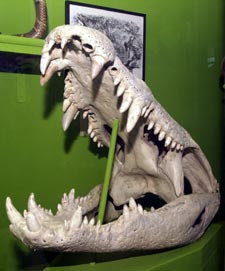My First Unofficial Tour
My first unofficial tour was immediately followed by another assignment to give a free tour to two ladies. One's Filipina and the other's from Ecuador. Arnold and I took turns in each stop at Fort Santiago until we reached Falsabraga de Media Naranja, a false wall shaped like half an orange. It's facing the Pasig river and right across this structure is Binondo. I delivered my commentary about the Pasig River and told them an interesting anecdote about probably the second biggest crocodile in the world that was captured there.
This I got from Ambeth Ocampo's book Bonifacio's Bolo. There's some criticism about Ocampo's methods but for the most part, I find his works engaging and provoking. It led me to do a little research to support this story.
I'm just glad that there's a even a picture.

The crocodile's head is on display at the Peabody Museum in Harvard University. It's called "Mugger" and it measures between 27 to 30 feet. The head is measured at 5-feet-6-inches from the nose to the first vertebra.
The story goes that in the 19th Century, a Frenchman named Paul P. de la Gironiere set out to hunt down the crocodile that has victimized people, a horse and a sheep. With the help of the locals, they were able to kill the crocodile which lasted over six hours. He donated the head to his American friend. This piece would then end up in the Peabody Museum of Harvard University.
* * *
Last week, the Mabuhay Guides had a tour of the Pasig River and Santa Ana de Sapa. We rode a ferry with Architect Manolo Noche as our guide. I really enjoyed his tour and he was able to impart very useful information. Among these are the following:
This I got from Ambeth Ocampo's book Bonifacio's Bolo. There's some criticism about Ocampo's methods but for the most part, I find his works engaging and provoking. It led me to do a little research to support this story.
I'm just glad that there's a even a picture.

MUGGER THE CROC. It's unbelievably huge and it was caught here in the Philippines.
The crocodile's head is on display at the Peabody Museum in Harvard University. It's called "Mugger" and it measures between 27 to 30 feet. The head is measured at 5-feet-6-inches from the nose to the first vertebra.
The story goes that in the 19th Century, a Frenchman named Paul P. de la Gironiere set out to hunt down the crocodile that has victimized people, a horse and a sheep. With the help of the locals, they were able to kill the crocodile which lasted over six hours. He donated the head to his American friend. This piece would then end up in the Peabody Museum of Harvard University.
Last week, the Mabuhay Guides had a tour of the Pasig River and Santa Ana de Sapa. We rode a ferry with Architect Manolo Noche as our guide. I really enjoyed his tour and he was able to impart very useful information. Among these are the following:
- There used to grand houses for rich families on the riverbanks of the Pasig. We saw one of the old houses in Santa Ana de Sapa and it faced the river.
- Binondo got its name from the local term "Minundoc" which means a small mountain. It became a Chinese settlement after the Chinese were expelled from the Parian following the 1593 murder of Governor-general Gomez Perez de Dasmariñas by Chinese galley rowers.
- Santa Ana de Sapa is one of the more important pre-Spanish settlements along the Pasig River. Originally known as Namayan (where people lived) it was ruled over by Lacantagcan and his wife Bouan. The area was subsequently colonized and evangelized by the Franciscans who established their first mission outside Intramuros in 1577. Here beside a brook, “sapa” they built their first church dedicated to St. Anne mother of the Virgin Mary.
